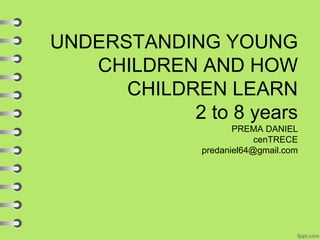
Child development
- 1. UNDERSTANDING YOUNG CHILDREN AND HOW CHILDREN LEARN 2 to 8 years PREMA DANIEL cenTRECE predaniel64@gmail.com
- 2. Domains of Development and characteristics of children THE EARLY CHILDHOOD COGNITIVE LANGUAGE SENSORY MOTOR PHYSICAL GROSS EMOTIONAL SOCIAL & PERSONAL • Energetic, curious and eager to learn • Creative and imaginative • Attention span is 7 to 15 minutes. • Thinking is perception bond and egocentric. Vocabulary limited and comprehension not adequate • Fine muscle • co ordination needs strengthening. • These skills are not sufficiently developed. • Need one to one adult attention. • Unique and have different styles of learning. Bones and muscles are in the process of development.
- 4. Bones in children are more porous than adults. A child's bones are more elastic. Bones in children permit a greater degree of deformation before they break.
- 7. THE BRAIN • In a brain, there are millions of neurons, which form the electrical connections that let us think. • These cells send their signals through axons . • Thicker the myelin sheath, quicker are the connections.
- 8. Even before your child is born, all the nerve cells she will ever possess have been formed.
- 9. These nerve cells are like a mass of unconnected electrical wires. From the time your child is born, her brain will constantly strive to connect the wires
- 10. Healthy curiosity and good language skills in the early years will lay the foundation for learning. The more a child explores and is exposed to new situations, the more that will matter to her, and the more she will want to learn. A POSITIVE CIRCLE
- 12. But what makes the wires connect and what does the connection mean to a growing child? Every time a child - is held, Is talked to Is read to Every time a child - sings and dances or plays with a toy Every time a child – has good nutrition has care and unconditional love The brain develops
- 13. OPTIMUM BRAIN DEVELOPMENT COMPARED TO A WELL DESIGNED KOLAM
- 14. But what prevents the wire connection and what does this mean to a growing child? • Every time you - • Scold a child • Hit or slap a child • List weak points of the child • Put undue pressure on the child • Make the child do things that her body is not ready to do. The brains stops growing
- 15. OVER STIMULATED –FORCED AND MADE TO DO THE DESIRES AND WANTS OF BOTH PARENTS AND TEACHERS ABCD 17698 Cat, mat, bat
- 16. Some parents and educators believe that a child is like a huge container. To insure the child's success, they think it their job to fill it up with as much information as possible, as quickly as possible. This misconception is damaging the brilliance of millions of our youth." - JW Wilson, Advanced Learning Institute Misconception
- 18. Multiple Intelligence the intelligence of the writers, poets, journalists, authors, and storytellers etc WORD SMART the intelligence of scientists and mathematicians, statistician, accountant computer programmers. LOGIC SMART the intelligence of the environmentalists botanists, veterinarians, ayurvedic practitioners . NATURE SMART the intelligence of artists and architects painter, chess player, sailor. PICTURE SMART The intelligence of composers. MUSIC SMART the intelligence of dancers and gymnasts Athletes, sculptors, surgeons, martial arts practitioners. BODY SMART the intelligence of statesmen & social activists, counselors, politicians, faith healers, effective Parents and teachers. PEOPLE SMART the intelligence of philosophers, Effective parents and teachers. SELF SMART
- 19. How do children learn EXPERIENCE (HANDS ON) 3-D LANGUAGE (the word you give) PICTURE 2 - D SYMBOL insect - ladybird E – L – P - S
- 20. Experience Where is there learning? Language Picture Symbol Language Picture Symbol Language Picture Experience
- 21. NEEDS OF CHILDREN 21 FREEDOM FROM UNDUE ADULT RESTRAINT THROUGH: - Exploration Experimentation Encouragement Challenge ADAPTING TO BE A MEMBER OF A COLLECTIVE BY: - Cooperating Listening Sharing Empathizing HAPPINESS OF ACHIEVEMENT FOR THE INDIVIDUAL THROUGH: - Opportunity Guidance Support Security and safety
- 23. SENSE OF SELF EMOTIONAL READINESS
- 27. UNDERSTANDING MENTAL & PSYCHOLOGICAL READINESS
- 29. The Curriculum • Focus on the child and not on the teacher the text books or the management • Activity based – play based • Focus on the all round development • Age appropriate, developmentally appropriate • Thematic approach • Free exploration to develop imagination and creativity • Rhymes, songs, stories, drama, music and dance • Readiness for school - learning to listen, speak, read and write and do math
- 30. pleasures of positive teaching • PASSION - Love unconditional love • PATIENCE – Endless amount is needed • PRACTICE – Let children repeat activities • PING –PONG – Parent , Teacher / child interaction ‘I do something, you do something.’ • SETTING THE STAGE – Provide a safe, interesting and learning environment.
- 31. Children say - DO • Take care of me. • Talk to me and listen to me. • Sing songs and tell me stories. • Play games with me. • Be my friend especially when you want to give advice. • Encourage me when ever possible • Help me to become independent. • Give me some of your time. • Be consistent in what you say and do.
- 32. CHILDREN SAY DON’T • Scold me, because I am not sure of what I am doing. • Never hit me or slap me. • Belittle me in front of strangers or friends or my family. • List my weak points in front of them • Put pressure on me. I cannot always be what you want me to be. • Make me do things that my body is not ready to do.
